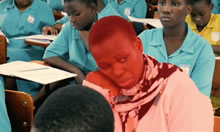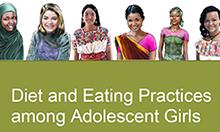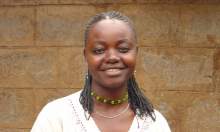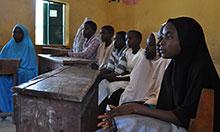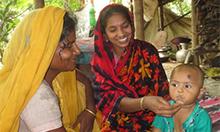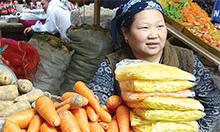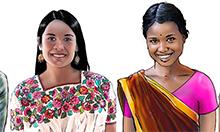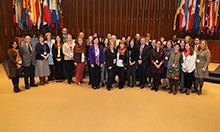Evidence, Guidance, and Gaps

Executive Summary
This report details a two-day high-level stakeholder consultation that was organized and co-hosted by United States Agency for International Development (USAID); SPRING; and the Pan American Health Organization (PAHO). The meeting was held at the PAHO headquarters in Washington, DC, on October 30–31, 2017. More than 40 global leaders working in adolescent girls’ nutrition participated, representing many academic and research institutions, nongovernmental organizations, UNICEF, the World Health Organization (WHO), and donor agencies.
This consultation built on an earlier meeting hosted by USAID, SPRING, PAHO, and the Food and Nutrition Technical Assistance III Project (FANTA) in 2015: the Technical Meeting on the Diet and Eating Practices of Adolescent Girls and Women of Reproductive Age. The 2017 stakeholder consultation brought experts in the field together again to review a new draft report—Diet and Eating Practices among Adolescent Girls in Low- and Middle-Income Countries: A Systematic Review. The consultation participants also discussed a summary of the forthcoming WHO document— Effective actions for improving adolescent nutrition—to share new background data and guidance documents and to define key evidence and implementation gaps, prioritize future research, and propose next steps in moving the adolescent nutrition agenda forward.
A growing focus on adolescent girls’ nutrition: The nutrition of the 900 million adolescent girls (ages 10–19) living today will have a profound impact on their current and future health. By sustaining healthy diet and eating practices during adolescence, they have the potential to address nutritional deficits and linear growth-faltering generated during the first decade of life and may limit harmful behaviors contributing to the epidemic of obesity and non-communicable diseases (NCD) in adulthood. Investing in female adolescent health brings triple dividends: better health for adolescents now, for their future adult lives, and for the lives of their children. Given that 16 million girls between the ages of 15 and 19 give birth each year, their nutritional status is important not only for them, but also for the health of their offspring.
The nutrition of adolescent girls was identified as a key priority in the 2013 The Lancet series on maternal and child nutrition. Furthermore, the global Accelerated Action for the Health of Adolescents (AA-HA!) Guidance to support country implementation revealed stark differences in the causes of death and disabilities when separating the adolescent age groups and sexes. The Global Strategy for Women's, Children's and Adolescents' Health 2016-2030—which aims to achieve the highest attainable standard of health for all women, children, and adolescents—underscores the importance of adolescent girls’ nutrition, for themselves and for their infants and children, if and when they become mothers.
However, current nutrition programming often does not prioritize this critical population. Although adolescent girls have shown growing interest in nutrition, knowledge of their current dietary practices and the impact of the changing food environment is limited, especially in low- and middle-income countries. Additionally, evidence is limited on the effectiveness of program interventions specifically targeting adolescent girls.
How the stakeholder consultation was structured: USAID, SPRING, and PAHO worked together to design the agenda for the stakeholder consultation, prioritizing issues and identifying research and program experiences to share. They invited experts and structured the agenda around three topics: evidence, guidance, and gaps. The objectives focused on reviewing the current state of evidence, existing guidance, relevant program and implementation experience, and research gaps and priorities related to adolescent girls’ nutrition. The presentations included (1) a review of the current evidence, with an in-depth presentation from the Demographic and Health Surveys (DHS) program on the comparative analyses of adolescent nutrition indicators by Dr. Rukundo Benedict; (2) the methods and findings from the systematic review on diet and eating practices among adolescent girls in low- and middle-income countries by Dr. Zulfiqar Bhutta and Dr. Emily Keats; (3) current WHO nutrition-related recommendations targeting adolescents by Dr. Pura Rayco-Solon; (4) Brazil’s food-based dietary guidelines by Dr. Carlos Montiero; (5) the interaction between food systems, food environments, diets, and nutrition among adolescents by Dr. Jessica Fanzo; and (6) the double burden and double duty actions for adolescents by Dr. Corinna Hawkes. Dr. Luz María De-Regil, Dr. Alison Tumilowicz, and Marcia Griffiths also presented examples of their work and facilitated discussions on program implementation, gaps, and challenges. Reflecting on the earlier presentations and inputs from various stakeholders, Dr. Rafael Pérez-Escamilla and Dr. Zulfiqar Bhutta led a final discussion on research gaps, challenges, and recommendations for future research.
Results and recommendations: The consultation produced a list of key evidence and implementation gaps about the diet and eating practices of adolescent girls in low- and middle-income countries and a summary of areas where additional guidelines and/or policy guidance may be needed:
Evidence Gaps, Research Actions, and Future Directions
| Evidence Gaps and Research Actions | Future Directions |
|---|---|
|
|
By the end of the consultation, stakeholders agreed on the need to raise further awareness about the evidence and implementation gaps, and to provide investment guidance. They also expressed interest in disseminating and operationalizing WHO recommendations on adolescent nutrition; conducting a global survey on adolescent nutrition, including qualitative research; developing indicators and gaining consensus on measurement; employing best practices in program design, encouraging investment in, and evaluating at-scale interventions; working multi-sectorally and including adolescents—to the greatest extent possible—throughout the entire research, program, and policy development processes.
